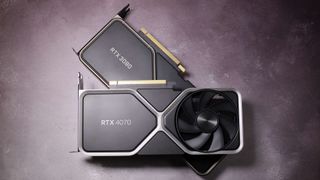Nvidia's allegedly cutting desktop GPU supply in favor of gaming laptop chips
But don't believe any scaremongering about an imminent graphics card supply crisis used to maintain pricing. If anything, prices could still go down.

Nvidia is reportedly diverting some desktop GPU manufacturing to keep the notebook market fed in China. That is according to a new report (via HardwareTimes) which claims gaming laptop manufacturers have been increasing their demands for the green team's mobile graphics chips.
The desktop DIY market for graphics cards is supposedly in a fairly robust state, and so the report suggests Nvidia isn't increasing production capacity and is simply pushing its Ada Lovelace GPUs over to the notebook makers instead of desktop manufacturing.
The expectation is that this would be around the RTX 4060 and RTX 4070 level of GPU, though given the machine translation it's not clear whether that refers specifically to desktop or mobile as they use different GPUs. The RTX 4070 in laptop land uses the same chip as the desktop RTX 4060 Ti, though the RTX 4060 is specced identically whichever platform you're running it on.
Whatever, it still means there will inevitably be a corresponding drop in the supply of the relevant desktop GPUs. The concern is that could mean supply of desktop graphics cards will start to become constrained and we end up in a situation where GeForce GPUs start to become scarce in retail later in the year
The cynic would say that this could be a possible move by Nvidia to maintain the high prices of its current range of graphics cards. The general consensus about the RTX 40-series is that they're good cards, just priced well above the odds. And with ample supply of these cards, and limited demand owing to the comparative pricing increase over the previous generation, there have been some retailers offering deals on select cards in order to increase sales.
If there is restricted supply, however, and fewer options to buy in the channel then it's easier for GPU manufacturers and Nvidia itself to maintain those high prices.
There were reports after the launch of the RTX 4070 that it was cutting production on the card owing to weaker than expected sales, but if Nvidia did indeed cut its manufacturing that hasn't had a material impact on the number of cards on sale.
The biggest gaming news, reviews and hardware deals
Keep up to date with the most important stories and the best deals, as picked by the PC Gamer team.
Looking around right now and if you want to buy an Nvidia GPU, particularly the RTX 4070, you have a wide range of options. Though resolutely at MSRP, it has to be said.
Still, I wouldn't worry that we're on the cusp of another GPU shortage. If Nvidia is indeed altering the flow of GPUs from desktop to notebook, then that is likely a natural restructuring based on inventory and market demands. And it's quite possibly not a global thing, either. The report purely talks about the China market, and there may well not be any change in supply on a worldwide basis.

Best CPU for gaming: The top chips from Intel and AMD.
Best gaming motherboard: The right boards.
Best graphics card: Your perfect pixel-pusher awaits.
Best SSD for gaming: Get into the game ahead of the rest.
I do wonder if we might get a bit of a price correction in the coming months, however. AMD is set to launch its new mainstream graphics cards—potentially in September after a late August announcement—and I would expect it to compete primarily in terms of pricing. Just as AMD chose to undercut the RTX 4060 with its RX 7600 release, it's looking likely that it will try and do the same to the RTX 4070 with its upcoming RX 7800 GPU.
With the RTX 4070 costing $599, the rumours have the RX 7800 set to launch around $549 at most, and could potentially outperform it in certain gaming benchmarks.
I wouldn't be at all surprised to see Nvidia try to spoil AMD's upcoming announcement of a new RDNA 3 graphics card or two by announcing a relatively significant drop in price for its own mid-range GPUs.
That would be nice, wouldn't it?

Dave has been gaming since the days of Zaxxon and Lady Bug on the Colecovision, and code books for the Commodore Vic 20 (Death Race 2000!). He built his first gaming PC at the tender age of 16, and finally finished bug-fixing the Cyrix-based system around a year later. When he dropped it out of the window. He first started writing for Official PlayStation Magazine and Xbox World many decades ago, then moved onto PC Format full-time, then PC Gamer, TechRadar, and T3 among others. Now he's back, writing about the nightmarish graphics card market, CPUs with more cores than sense, gaming laptops hotter than the sun, and SSDs more capacious than a Cybertruck.
Most Popular






